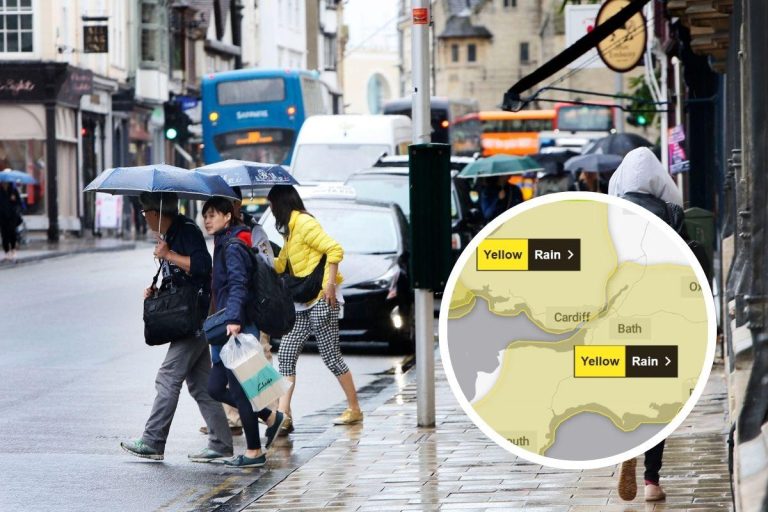Tens of thousands of homes, farms, and businesses in Ireland lost power on Saturday due to Storm Bert, which caused widespread disruptions across the country. In the United Kingdom, several rail lines and roads were shut down because of what forecasters described as a “multi-hazard event.” The storm brought intense wind, rain, snow, and ice, triggering yellow and amber weather warnings throughout most of the UK.
In Scotland, Wales, and northern England, the storm began to intensify early on Saturday morning. The Met Office warned of the potential for heavy snowfall, particularly in higher elevations, which would create hazardous driving conditions and further disrupt transportation. Social media users shared images and videos of snow blanketing the roads, causing significant travel delays.
Meanwhile, in Ireland’s Donegal county, floodwaters rose dangerously high, submerging parked cars in the town of Killybegs. The flooding followed intense rainfall from Storm Bert, which had already prompted the Irish Meteorological Service to issue a “status red” warning—the highest level—specifically for the counties of Cork and Galway. The torrential rain made several roads impassable, severely affecting local transportation and public safety.
The Met Office’s Chief Meteorologist, Jason Kelly, highlighted the severity of the storm as it moved across the United Kingdom, describing it as a “multi-hazard event.” This forecast predicted not only significant snowfall but also periods of heavy rain and strong winds. As the storm continued its path, it left behind widespread damage, including power outages and structural damage from fallen trees and debris.
In Scotland, several rail services were suspended due to the severe weather. ScotRail confirmed that some of the region’s most popular tourist routes, including Inverness-Elgin and Aberdeen-Inverurie, had been temporarily halted. The suspension of these services created additional challenges for travelers and residents trying to navigate the storm.
Storm Bert’s destructive force was felt across multiple regions of the UK. The combination of snow, ice, and heavy rain left roads treacherous and led to multiple accidents. Emergency services responded to numerous calls for assistance, rescuing stranded drivers and providing aid to those trapped by rising floodwaters.
The ongoing threat of Storm Bert prompted multiple advisories from weather agencies, urging people to stay indoors and avoid unnecessary travel. Authorities warned that the storm’s progression could continue to bring extreme weather conditions well into the weekend, creating more hazards for both the general public and emergency response teams.
As Storm Bert battered the coastlines of Ireland and the UK, residents braced for further disruptions. The Irish Meteorological Service issued flood warnings across multiple counties, with particular concern over the west coast. The combination of high winds and persistent rain contributed to already swollen rivers, exacerbating the flood risks.
The transportation network across both Ireland and the UK struggled to cope with the storm’s impact. In addition to train delays and closures, many roads were closed or rendered unsafe due to snow, ice, and floodwaters. Drivers were urged to take caution, and many were advised to stay off the roads entirely until conditions improved.
In the UK, authorities scrambled to respond to the challenges presented by Storm Bert. Many regions saw snow and ice accumulate quickly, particularly on higher ground. The snow was expected to continue through the weekend, and meteorologists predicted that temperatures would drop further, adding to the risk of icy conditions.
In response to the widespread disruption, the UK government implemented emergency measures to support affected communities. The army was placed on standby to assist with flood relief efforts and help clear blocked roads. Additionally, public transportation systems in affected regions were re-routed or temporarily halted to ensure the safety of commuters and workers.
The storm also highlighted the vulnerability of rural areas in both the UK and Ireland. In Ireland, farmers faced additional challenges due to power outages, which interrupted operations on farms. With cold temperatures and snow blanketing the fields, the loss of power disrupted heating systems and livestock care.
The devastating effects of Storm Bert underscored the growing risks posed by extreme weather events. As climate change accelerates, such “multi-hazard events” are becoming more common, with both short-term and long-term consequences. Experts warn that communities in storm-prone regions will need to prepare for increasingly severe weather patterns in the coming years.
Across both Ireland and the UK, people worked together to help those in need. Community groups mobilized to assist with flood evacuations, and volunteers helped deliver supplies to vulnerable individuals. In some areas, shelters were set up to accommodate those displaced by the storm, offering a refuge from the harsh conditions outside.
As the storm began to subside, authorities continued to monitor the situation closely. Although the worst of the storm had passed, the damage caused by the heavy rains, snow, and winds would take time to fully assess. Many areas remained at risk of flooding, and more precautions were needed as additional rain was forecast for the following days.
While Storm Bert finally started to lose strength by Sunday, it left a lasting impact on both Ireland and the United Kingdom. The recovery process would be slow, with local authorities working to restore power, clear blocked roads, and ensure that essential services were back up and running. Communities across both countries faced the aftermath of the storm with resilience, preparing for the next challenge in an era of increasingly unpredictable weather patterns.

